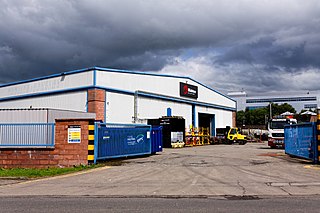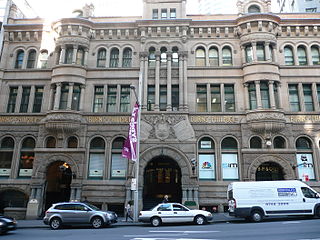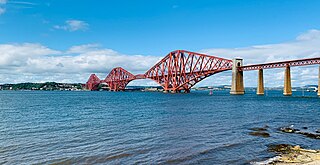
The Barclay Curle Crane is a disused Titan or giant cantilever crane at the Barclay Curle shipyard at Whiteinch, Glasgow, Scotland.

The Barclay Curle Crane is a disused Titan or giant cantilever crane at the Barclay Curle shipyard at Whiteinch, Glasgow, Scotland.
It was built by Sir William Arrol & Co. in 1920. [1] [2] It is category A listed, and one of four such cranes remaining on the River Clyde. [1]
The crane was rated at 150 tonnes (150 long tons; 170 short tons). [2]
Brush Traction is a manufacturer and maintainer of railway locomotives in Loughborough, England. It is a subsidiary of Wabtec.

The Hunslet Engine Company is a locomotive-building company, founded in 1864 in Hunslet, England. It manufactured steam locomotives for over 100 years and currently manufactures diesel shunting locomotives. The company is part of Ed Murray & Sons.

Andrew Barclay Sons & Co., currently operating as Brodie Engineering, is a builder of steam and later fireless and diesel locomotives. The company's history dates to foundation of an engineering workshop in 1840 in Kilmarnock, Scotland.

Sentinel Waggon Works Ltd was a British company based in Shrewsbury, Shropshire that made steam-powered lorries, railway locomotives, and later, diesel engined lorries, buses and locomotives.

The Finnieston Crane or Stobcross Crane is a disused giant cantilever crane in the centre of Glasgow, Scotland. It is no longer operational, but is retained as a symbol of the city's engineering heritage. The crane was used for loading cargo, in particular steam locomotives, onto ships to be exported around the world.

Burns Philp was once a major Australian shipping line and merchant that operated in the South Pacific. When the well-populated islands around New Guinea were targeted for blackbirding in the 1880s, a new rush for labour from these islands began. James Burns and Robert Philp purchased several well-known blackbirding ships to quickly exploit the human resource in this region, and Burns Philp entered the slave trade. The company ended its involvement in blackbirding in 1886. In later years the company was a major player in the food manufacturing business. Since its delisting from the Australian Securities Exchange in December 2006 and the subsequent sale of its assets, the company has mainly become a cashed up shell company. It is wholly owned by Graeme Hart's Rank Group.

UD Trucks Corporation is a Japanese company whose principal business is the manufacturing and sales of diesel trucks, buses, bus chassis and special-purpose vehicles. Its headquarters are located in Ageo, Saitama, Japan. The company is a wholly owned subsidiary of Isuzu since 2021. Until 2010, the company was known as Nissan Diesel.
Seawind Barclay Curle is a British shipbuilding company.

Titan Clydebank, more commonly known as the Titan Crane is a 150-foot-high (46 m) cantilever crane at Clydebank, West Dunbartonshire, Scotland. It was designed to be used in the lifting of heavy equipment, such as engines and boilers, during the fitting-out of battleships and ocean liners at the John Brown & Company shipyard. It was also the world's first electrically powered cantilever crane, and the largest crane of its type at the time of its completion.

Sir William Arrol & Co. was a leading Scottish civil engineering and construction business founded by William Arrol and based in Glasgow. It built some of the most famous bridges in the United Kingdom including the second Tay Bridge, the Forth Bridge and Tower Bridge in London.
Domala was an 8,441-ton cargo liner which was built in 1920 and launched as Magnava. Following damage sustained in an air attack in 1940, she was rebuilt as a cargo ship and renamed Empire Attendant. In 1942 she was torpedoed and sunk with the loss of all crew.
The MV Dara was a Dubai-based passenger liner, built in 1948 by Barclay, Curle & Co. Ltd., a shipyard in Glasgow, Scotland. The 120-metre (390 ft), four-decked vessel travelled mostly between the Persian Gulf and the Indian subcontinent, carrying expatriate passengers who were employed in the nations of the Gulf.
MV Nottingham was a refrigerated cargo motor ship that was built in Scotland in 1941 for the Federal Steam Navigation Co. On her maiden voyage a u-boat torpedoed her, sinking her with all hands.
Philips Wouwerman was a 7,091 GRT cargo ship that was built in 1942 as Empire Courage by Barclay, Curle & Co Ltd, Glasgow, United Kingdom. She was built for the Ministry of War Transport. in 1943, she was transferred to the Dutch Government and renamed Philips Wouwerman. In 1947, she was sold into merchant service and renamed Ceram. A further sale in 1953 saw her renamed Amsteltoren and then Amstelbrug. In 1959, she was sold to Greece and renamed Armathia. A further sale in 1965 saw her renamed Calliman. She served until scrapped in 1968.

The Forth Bridge is a cantilever railway bridge across the Firth of Forth in the east of Scotland, 9 miles west of central Edinburgh. Completed in 1890, it is considered a symbol of Scotland, and is a UNESCO World Heritage Site. It was designed by English engineers Sir John Fowler and Sir Benjamin Baker. It is sometimes referred to as the Forth Rail Bridge, although this has never been its official name.

The Fairfield Titan was a giant cantilever crane at BAE Systems' Govan shipyard, and the largest such crane on the River Clyde until it was demolished in 2007.

The James Watt Dock Crane is a giant cantilever crane situated at Greenock on the River Clyde.
The Beardmore Crane was a giant cantilever crane at the William Beardmore and Company yard.

A block-setting crane is a form of crane. They were used for installing the large stone blocks used to build breakwaters, moles and stone piers.

The Arrol Gantry was a large steel structure built by Sir William Arrol & Co. at the Harland and Wolff shipyard in Belfast, Ireland. It was built to act as overhead cranes for the building of the three Olympic-class liners.